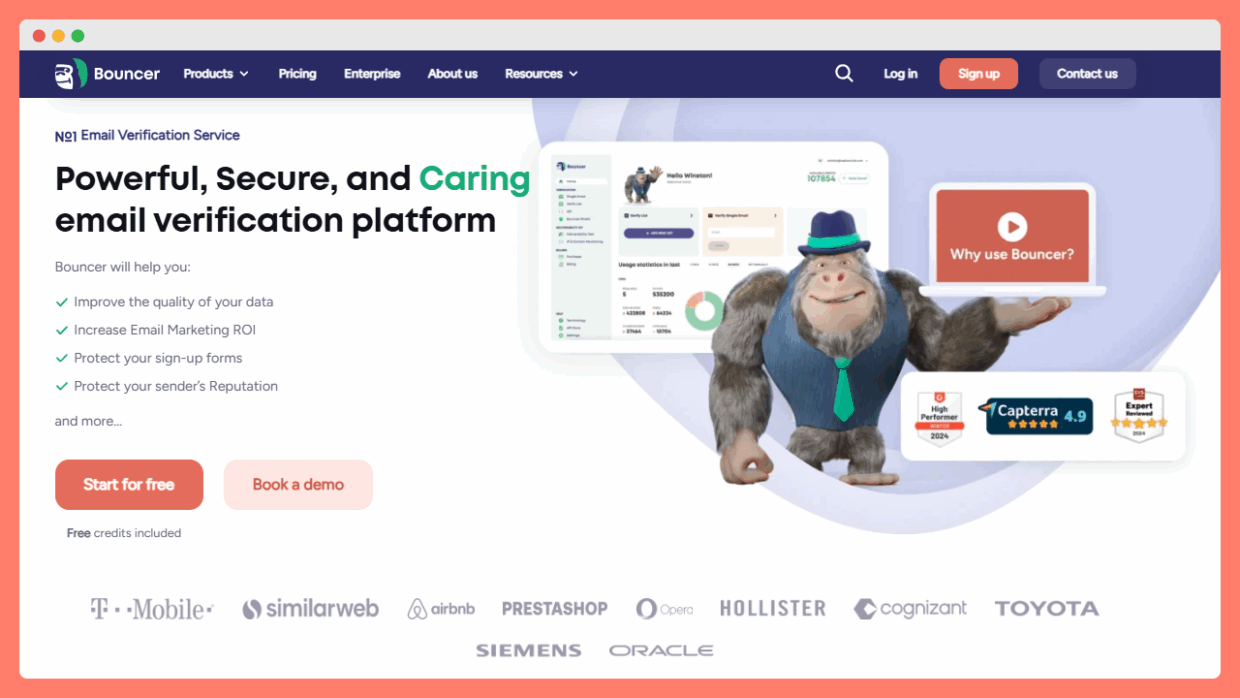That’s why the question “does email verification reduce bounce rate?” matters so much to businesses, marketers, and anyone relying on email as a channel.
The short answer is yes, email verification can dramatically reduce bounce rates. And in doing so, safeguard your sender reputation, maximize your deliverability, and increase your campaign ROI. But to see why and how, let’s dig deeper.
Why do email bounces matter in email marketing?
When you send email marketing campaigns, your messages pass through a gauntlet of filters, checkpoints, and reputation checks before ever reaching a recipient’s inbox.
Any time an email bounces—meaning it can’t be delivered for one reason or another—that’s a signal to email providers, spam filters, and internet service providers (ISPs) that your list may not be trustworthy.
There are two main types of email bounces:
- Hard bounces are permanent failures. These occur when you send to a non existent email address, invalid addresses, or domains that simply don’t exist anymore.
- Soft bounces are temporary problems, such as a recipient’s mailbox being full, the email server being down, or the message being blocked for size or security reasons.
Both types can be a problem, but hard bounces are especially damaging because they indicate your email list isn’t up-to-date or properly maintained.
Over time, high bounce rates signal poor sending practices, leading to poor sender reputation, which can affect your future campaigns.
How do high bounce rates affect sender reputation?
Sender reputation is like a credit score for email marketers.
Email service providers and ISPs track the quality of your sending practices—how many emails are delivered successfully, how many bounce, how often people mark your messages as spam, and so on.
When an email fails to reach the recipient’s email address, it’s often due to:
- 1. Issues with the recipient’s email server
- 2. A full inbox
- 3. Permanent delivery failures
These are the classic cases where hard bounces occur.
Analyzing bounce rates can reveal patterns, such as whether your email content or even your subject line contains spam trigger words that keep messages from being successfully delivered. If you understand why hard bounces occur and monitor which emails fail, you can refine your lists and tweak content to ensure future campaigns have a much higher chance of reaching the inbox.
If your average bounce rate is high, your reputation takes a hit. Over time, this can lead to several problems:
- Your emails start landing in the spam folder instead of the inbox
- Email providers throttle or block your messages entirely
- Your email marketing efforts deliver fewer results, even if your content is great
- Spam filters flag you as a problematic sender, making future delivery harder
That’s why managing bounce rates is so important—and why the question of “does email verification reduce bounce rate” is more than just technical detail; it’s the key to sustainable email marketing.

Why do bounces happen? (and why do they keep happening?)
Let’s break down some of the most common reasons for email bounces:
- Invalid email addresses – People mistype their email during signup, or you inherit a list with errors and outdated info.
- Non existent email address – A user deletes their account, changes jobs, or abandons an old email.
- Incorrect email addresses – One character wrong, and your message goes nowhere.
- Disposable email addresses – Some users sign up with temporary emails just to get a quick benefit (like a free download), then abandon them.
- Full mailbox – If a recipient’s mailbox is full, your message bounces back as undeliverable.
- Temporary server issues – Sometimes, the recipient’s mail server is down or can’t accept messages temporarily.
- Security settings – A recipient’s domain or server may block your messages due to strict filtering or failed authentication settings.
The root cause? Email lists degrade over time. If you don’t regularly verify email addresses, even your best-maintained list can become a source of bounced emails, poor deliverability, and wasted marketing effort.
Does email verification reduce bounce rate? Here’s the truth
Now, the main question: does email verification reduce bounce rate?
The evidence (and the experience of every seasoned marketer) says yes.
Here’s why.
Email verification is the process of checking every address on your list to make sure it is valid, correctly formatted, able to receive emails, and not a trap for spam filters. A good email verifier (like Bouncer) runs several checks in just a few clicks:
- Syntax validation: Checks for common typos and ensures the email address is properly formatted (no missing “@” or extra spaces).
- Domain validation: Confirms that the domain exists and can accept emails.
- MX record checks: Looks up DNS records to confirm there’s a mail server ready to receive email for that domain.
- SMTP server checks: Connects to the recipient’s mail server using a secure TCP connection to verify if the mailbox is valid (sometimes even using the VRFY command, depending on the server’s security settings).
- Disposable email address detection: Flags addresses that use temporary, throwaway services that are unlikely to be monitored by real users.
- Identifies full mailboxes, spam traps, and problematic addresses that can harm your deliverability.
By running all these checks, you can remove invalid emails, correct typos, and confirm the recipient’s mailbox is able to accept messages before you ever hit send.
The result?
Your bounce rates drop, more emails are delivered successfully, and your sender reputation improves.
The real-world impact: how verification helps every campaign
Let’s get practical. Here’s how email verification fits into everyday email marketing campaigns:
- You reduce bounce rates. Removing invalid, non-existent, or temporary addresses means fewer emails bounce back. Your average bounce rate drops—and that’s a key metric every marketer should watch.
- You protect your sender reputation. Each time you send to a clean, verified list, you’re sending the right signals to email providers. Over time, this builds a good sender reputation, helping your future campaigns land in the inbox, not spam.
- You enhance email deliverability. Fewer bounces means more of your messages reach intended recipients. Improved deliverability is a virtuous cycle: the better your reputation, the higher your inbox placement rate.
- You improve your email marketing ROI. Why pay to send messages to dead or incorrect email addresses? When you verify email addresses, your spend goes further, and your engagement rates rise.
- You avoid spam complaint rate spikes. Old, recycled, or problematic addresses are often recycled as spam traps. Hitting these can trigger spam complaints, another red flag for email providers.
- You maintain a healthy email list over time. Regular validation (not just a one-off check) keeps your email list in top shape, even as addresses change, get abandoned, or expire.
Why Bouncer is the best email verification tool for reducing bounce rates

While there are many email verification tools on the market, Bouncer consistently earns high marks from businesses, agencies, and solo marketers alike.
Here’s why Bouncer is a trusted choice for reducing bounce rates and keeping lists healthy:
- Accuracy and depth: Bouncer’s platform doesn’t just check syntax. It performs domain validation, authenticates with recipient mail servers, detects disposable and temporary addresses, and flags full mailboxes, all in real time.
- Bulk processing: Whether you’re cleaning a small campaign or hundreds of thousands of addresses, Bouncer can process mailing lists of any size efficiently.
- Email verification API and integrations: Easily connect Bouncer to your CRM, marketing platform, or even Google Sheets to validate addresses as users sign up or your list grows.
- Actionable results: Bouncer’s reports don’t just tell you which addresses failed—they explain why, so you can correct typos, reach out for updated info, or clean your data.
- Improved deliverability: Businesses that use Bouncer report higher open rates, fewer spam folder placements, and better long-term sender reputation with reputable email service providers.
- Security: Bouncer uses encrypted connections and never sends actual messages to addresses being checked, so your data and your recipients’ privacy are safe.

By building Bouncer into your double opt in process or regular list maintenance, you make email verification part of your marketing DNA—so every campaign starts with a list that’s ready to deliver results.
Best practices: how to use email verification to your advantage
To really see the benefits, make email verification a habit, not a one-time fix. Here’s how to weave it into your routine:
- 1. Validate every new subscriber
Use a verification email or API to double check every new signup before adding them to your main list. This catches typos and spam traps at the source.
- 2. Clean your full list regularly
Even well-maintained lists degrade—set a schedule (monthly or quarterly) to run your list through an email verifier.
- 3. Remember about verification always before every major campaign
If you’re launching a big product or running a major promotion, always verify email addresses first to ensure maximum deliverability.
- 4. Integrate with Google Sheets or your CRM
If your business relies on spreadsheets, connect a tool like Bouncer so validation is just a few clicks away.
- 5. Analyze your bounce rates
Monitor key metrics after each campaign. If your bounce rate starts to climb, it’s time to clean house.
- 6. Watch for patterns
Are certain domains, sources, or signup forms producing more invalid addresses? Adjust your data collection and double opt in process to prevent bad addresses from getting through.
What happens if you don’t verify your email list?
Failing to verify your list is risky business. Here’s what can go wrong:
- Higher bounce rates: Invalid or non-existent addresses lead to more bounced emails, hurting your sender reputation.
- Poor sender reputation: ISPs and email providers will throttle or block your messages if your bounce and spam complaint rates spike.
- Lower deliverability: More emails land in the spam folder, fewer reach the inbox.
- Wasted marketing spend: You pay for emails that never reach their intended recipients.
- Less reliable analytics: Your email metrics—open rates, click rates, conversions—are skewed by the presence of undeliverable addresses.
The verdict: does email verification reduce bounce rate? Yes—and it delivers much more
The answer couldn’t be clearer: email verification is essential to reduce bounce rates, protect your sender reputation, and ensure your messages are delivered to the right inboxes. In the ever-changing world of email marketing, keeping your lists clean isn’t just a technical detail—it’s a key part of every successful marketing strategy.
By using a reliable tool like Bouncer to regularly verify email addresses, you give every campaign the best shot at success.
You maintain a good sender reputation, dodge the spam folder, and keep your brand connected to real people—not outdated or problematic addresses.
Whether you’re dealing with hard and soft bounces, running complex campaigns, or just want to keep your metrics honest, email verification is your frontline defense.
Try Bouncer. Make it part of your routine. Just watch your bounce rates fall, your deliverability soar, and your results improve with every send.


